The ascent of McGill's trees
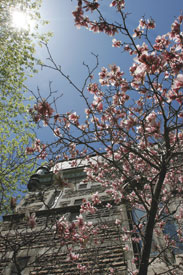
One of the earliest trees to flower in spring, this magnolia was planted in the '70s beside Morrice Hall, one of 300 trees planted during the '70s, '80s and '90s under the guidance of Sam Kingdon, vice-principal (planning and physical resources), who retired in 1996.
Owen Egan
There's no escaping them. They are everywhere. At times they beckon you to sit in their shade and open a book or, better still, lie a moment at their feet and watch the sky slip away behind the contours of their leaves. Other times, it's enough to pass by and take in the pink and white clouds of crabapple blossoms in May, the honeyed perfume of the linden's yellow flowers in July, or the shrieking of the squirrels in the fall, chasing each other through the walnut tree's vast canopy.
At all times, they punctuate and shape the space we call the downtown campus; they're a semi-colon connecting the cellulose forest of Mount Royal to the stone, glass and human forest of the city. They are the trees of McGill and, after 150 years, they are more numerous and more diverse than ever. In fact, with the worst of the years of competition with cattle, fungi and beetles seemingly over, with building construction near saturation, and with a highly organized post-ice-storm-of-1998 plan for care of the silent members of the campus, you could say that McGill's 900 trees are in full ascent.
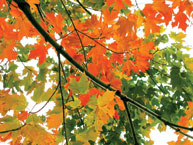
The turning of the leaves of the appropriately named red maple announces fall on campus.
Claudio Calligaris
To put such a claim in context, consider some of the highs and lows in their 184 years on campus. In the early days of McGill College, as it was named when it opened in 1821, trees weren't important. There wasn't much landscaping and the trees that remained from James McGill's estate - a row of butternuts, a few oaks and one mature elm - were preyed upon by roaming cattle. In those days, part of a professor's pay was grazing rights for his livestock.
The other threat to the landscape was the bank; the fledgling university was in constant financial peril and the early principals had to sell off parcels of land in order to keep the college going. Much of that land was below Sherbrooke Street.
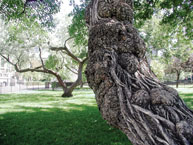
The curves of the Russian olive and the spindle tree beyond it create inspiring shadows.
Claudio Calligaris
It was only with the arrival of Sir William Dawson in 1855 that the downtown campus we know today began to take shape. Principal Dawson put an end to cattle-grazing and planted at least 40 American elms, Ulmus americanus, all along the perimeter of each of the halves of the lower campus. He believed that if he could attract more students to McGill with the beauty of the landscape, he could save the university from having to sell off more property.
At the same time as he planted the elms, he planted behind them a row of faster growing silver maples, Acer saccharinum, of which at least one remains. Holding court in the lower southeast quadrant, behind the statue of James McGill, the grande dame is easily distinguished by her thick reddish trunk and the graceful fronds of deeply lobed silvery leaves.
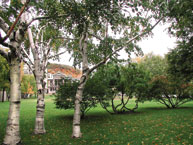
McGill's trees, like these white birch growing near Sherbrooke Street, create a buffer zone between Mount Royal and downtown.
Claudio Calligaris
Dawson leapt at any opportunity to increase the number and variety of trees at McGill. In the early 1880s, areas newly defined by the addition of buildings such as the Redpath Museum and the Macdonald Chemistry Building (now home of the School of Architecture) required landscaping. In the hollow beside the Redpath, for instance, Dawson planted a black walnut, Juglans nigra, reputedly the first ever in Montreal.
The tallest tree in the hollow, and perhaps of all of McGill's 900 downtown trees, the 125-year-old nut tree is thriving thanks, in part, to its brilliant strategy of poisoning the ground around it, which discourages competition from growing too close by. Look up and you'll see the bright green casings of the nuts amid its multi-leafleted leaves. If you're lucky enough to find one on the ground, smell the husk; what you get a whiff of is juglone, toxic to plants but used by the Greeks and Romans against skin fungi.
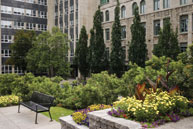
These five columnar English oaks keep their leaves in the winter, lending warmth to the stone architecture of the McConnell Engineering Building.
Claudio Calligaris
Just far enough south of the walnut, Dawson planted another exotic species, a catalpa, Catalpa speciosa. While that tree died around 1920, one of its offspring lives on in the garden across the avenue from Redpath Hollow, thanks to David Penhallow, McGill's first professor of botany, who saved the seeds from the mother tree and grew the sapling. The catalpa's distinctive blackened trunk and craggy branches make the tree look dead for most of the year, and with its Leaning-Tower-of-Pisa angle, you can't miss this tree. Look up and you'll see its characteristic long, thin seed pods. Next July, be sure to look up again to see its striking orchid-like white flowers.
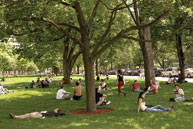
In the heat of summer, the big, old maples on the east side of the lower Campus are magnets for students, staff and members of the public alike.
Claudio Calligaris
If you look at this old catalpa from the park in front of the Macdonald-Harrington (architecture) Building, you'll notice that you can actually see through this tree - its trunk is hollow. Still, for as long it's alive (the living part of the tree is in the sapwood just beneath the bark) and posing no danger, the campus gardeners will let it stand, reports Eric Champagne, McGill's horticulturalist. The grounds staff have, however, planted a young one beside it in preparation for the elder's eventual demise.
Just as Penhallow tried to maintain a continuity of McGill's tree species, all the while adding new ones, so too are Champagne, his crew and the members of the Gardens and Grounds Committee.
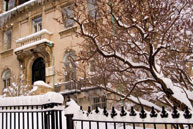
An old lilac points the way to the Macarow House, home of the Institute of Air and Space Law on Peel Street.
Claudio Calligaris
This explains the presence of a Siberian elm, Ulmus pumila, a scruffy-looking teenaged elm flanked by bicycle racks in front of the architecture building entrance. It will never be as tall and as elegant as was the "Founder's Elm" that grew to 35 metres and whose canopy once shaded the entire area around where its memorial cement now stands, but it will not succumb to the Dutch elm disease that took all of the lower campus elms during the 1960s and '70s, the last one being the Founder's in 1976. Siberian elms are resistant to the disease where American elms rarely are. (A few American elms, however, persist on campus on the residence grounds on Mount Royal.)
The loss of the trees that for 60 years had characterized the campus was a lesson in the perils of monoculture: when disease strikes, all risk falling. It made planting for diversity instead of uniformity no longer a choice but a necessity. And planting, during those years, was going on at a furious pace; diseased trees needed to be replaced, and the new buildings that went up in the 1950s and '60s to accommodate the first wave of baby boomers meant more landscaping had to be done.
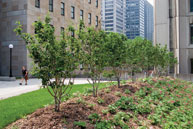
Among the most recent additions to McGill's landscape is this row of serviceberry trees between the Otto Maas and Macdonald Physics buildings. They will be full of white flowers in spring and dark red fruit in fall.
Claudio Calligaris
According to the Dec. 6, 1969, McGill Reporter, students even staged a funeral for the 14 Lombardy poplars that had to be sacrificed for the construction of Burnside Hall. Quebec human rights lawyer Julius Grey, then the president of the Students' Society had this to say: "Very interesting, this struggle for self-determination of trees. I think trees now have to join with women and other persecuted sectors of our society."
Trees did get their voice, even if it took some a long time to be heard. Just last summer, 30 years after the construction in the southeast corner of the campus, a row of serviceberry trees, Amelanchier canadensis, were planted. They bear lacy white blossoms in the spring and sweet dark purple berries in mid-summer.
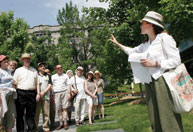
Last spring's tour of McGill's trees takes in the new sugar maples, beech and ironwood trees near the Trottier Building.
Owen Egan
When construction began a few years ago in "Tech Square," for instance, in front of the Strathcona Anatomy and Dentistry building, great effort was made to relocate whatever trees could be moved. When it came time to landscape between the Trottier and Penfield 740 buildings, care was taken to plant trees and native grasses that would complement the remaining old trees. A grove of sugar maples, Acer saccharum, and a new beech, Fragus grandifolia, were planted near the white ash, Fraxinus grandifolia, in front of Strathcona; the three species frequently coexist in St. Lawrence valley forests. The beech is easily distinguished by its grey, smooth bark while the ash has seven leaflets on a central stalk and a straight trunk with a coarse diamond pattern in its bark.
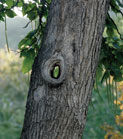
Although you are able to see right through this hollow old catalpa, there's enough life left in the sapwood to keep producing leaves and seeds.
Owen Egan
Ironically, some of the construction refugees from "Tech Square" ended up in McGill's oldest tree site: the circle of trees near the Founder's Elm. It's a bit of a motley crew here, but among the pedestrian - at least for McGill - lindens, maples and oaks are representatives of old and endangered tribes. One is an American chestnut, Castanea dentata. Like the elm, this once common eastern North American tree was almost wiped out by blight. A few years ago, biology professor and member of the Gardens and Grounds Committee, Martin Lechowicz, found a healthy grove of chestnuts growing near Ithaca, New York and brought back and germinated a nut. The resultant tree, despite looking a little dried out by the hot summer, is bearing its own fruit this fall. "These chestnuts taste even better than the Italian ones we roast at Christmas," says Lechowicz.

Photographer snaps a shot in the afternoon light.
Owen Egan
The sight of those nuts, protected under furry, burry husks, fills Eric Champagne with satisfaction. "This is what can happen in a university environment. You have the luxury and the knowledge to do things like this." And the trees grow on.
A two-hour tour of the Trees of McGill, led by Bronwyn Chester, leaves next Sunday, October 16, at 10 am from the steps of the Redpath Museum. Please call 398-4086 x 4094 to register. $10 for adults, $5 for kids and students.

